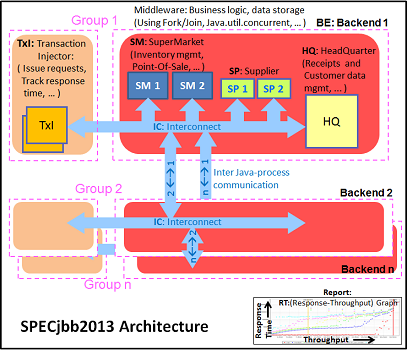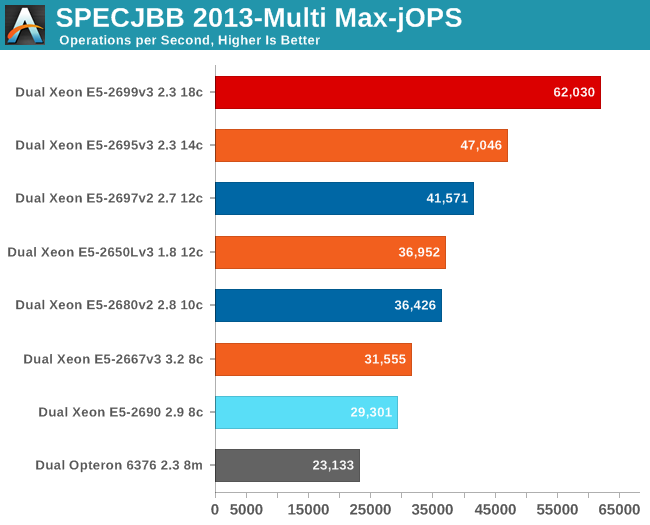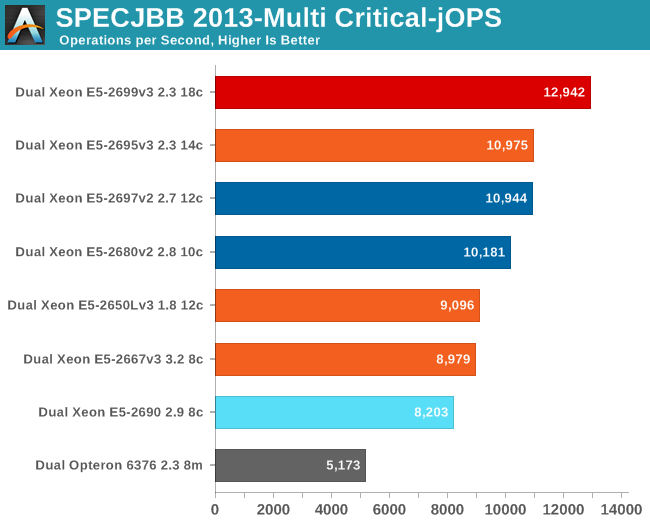Intel Xeon E5 Version 3: Up to 18 Haswell EP Cores
by Johan De Gelas on September 8, 2014 12:30 PM ESTJava Server Performance
According to the documentation, the SPECjbb 2013 benchmark has "a usage model based on a world-wide supermarket company with an IT infrastructure that handles a mix of point-of-sale requests, online purchases, and data-mining operations". It uses the latest Java 7 features and makes use of XML, compressed communication, and messaging with security. We tested with four groups of transaction injectors and backends.

Several readers commented that we should try to optimize for lower response times instead of just optimizing for maximum throughput, so we have changed our relatively basic tuning. We left out "+AggressiveOpts" as this is still somewhat a risk for stability and the performance does not increase tangibly, and we used "-XX:+AlwaysPreTouch". Also we are more generous with the amount of allocated memory. These results are thus no longer comparable to our previous results. Our full parameters are:
"-server -Xmx8G -Xms8G -Xmn4G -XX:+AlwaysPreTouch -XX:+UseLargePages"
With these settings, the benchmark takes about 47GB-52GB of RAM. The first metric is basically maximum throughput.

Our new tuning has resulted in higher results, and all of the new Xeon scale well. However, if you start looking at it from a performance/watt perspective, the results are good but not spectacular. The power consumption of the Xeon E5-2695 v3 is similar to the Xeon E5-2697 v2, and the former has a 13% performance advantage.
The Critical-jOPS metric, is a throughput metric under response time constraint (SLA).

With our new tuning, the critical jOPS make a lot more sense, so we believe we have taken a step forward. Notice that the Xeon E5-2695 v3, despite its clock speed disadvantage (2.3 at least, 2.8 at the most), is capable of keeping up with the Xeon E5-2697 v2 (2.7 at the least, 3GHz at the most). The improvements in Haswell are measureable.
However, it must be said that while this is a step forward if you're buying a server, it's not a large one. You get 13% more throughput and the same response time for a few hundred dollars less (Xeon E5-2695 v3 vs E5-2697 v2).










85 Comments
View All Comments
coburn_c - Monday, September 8, 2014 - link
MY God - It's full of transistors!Samus - Monday, September 8, 2014 - link
I wish there were socket 1150 Xeon's in this class. If I could replace my quad core with an Octacore...wireframed - Saturday, September 20, 2014 - link
If you can afford an 8-core CPU, I'm sure you can afford a S2011 board - it's like 15% of the price of the CPU, so the cost relative to the rest of the platform is negligible. :)Also, s1150 is dual-channel only. With that many cores, you'll want more bandwidth.
peevee - Wednesday, March 25, 2015 - link
For many, if not most workloads it will be faster to run 4 fast (4GHz) cores on 4 fast memory channels (DDR4-2400+) than 8 slow (2-3GHz) cores on 2 memory channels. Of course, if your workload consists of a lot of trigonometry (sine/cosine etc), or thread worksets completely fit into 2nd level cache (only 256k!), you may benefit from 8/2 config. But if you have one of those, I am eager to hear what it is.tech6 - Monday, September 8, 2014 - link
The 18 core SKU is great news for those trying to increase data center density. It should allow VM hosts with 512Gb+ of memory to operate efficiently even under demanding workloads. Given the new DDR4 memory bandwidth gains I wonder if the 18 core dual socket SKUs will make quad socket servers a niche product?Kevin G - Monday, September 8, 2014 - link
In fairness, quad socket was already a niche market.That and there will be quad socket version of these chips: E5-4600v3's.
wallysb01 - Monday, September 8, 2014 - link
My lord. My thought is that this really shows that v3 isn’t the slouch many thought it would be. An added 2 cores over v2 in the same price range and turbo boosting that appears to functioning a little better, plus the clock for clock improvements and move to DDR4 make for a nice step up when all combined.I’m surprised Intel went with an 18 core monster, but holy S&%T, if they can squeeze it in and make it function, why not.
Samus - Monday, September 8, 2014 - link
I feel for AMD, this just shows how far ahead Intel is :\Thermogenic - Monday, September 8, 2014 - link
Intel isn't just ahead - they've already won.olderkid - Monday, September 8, 2014 - link
AMD saw Intel behind them and they wondered how Intel fell so far back. But really Intel was just lapping them.